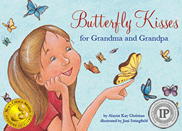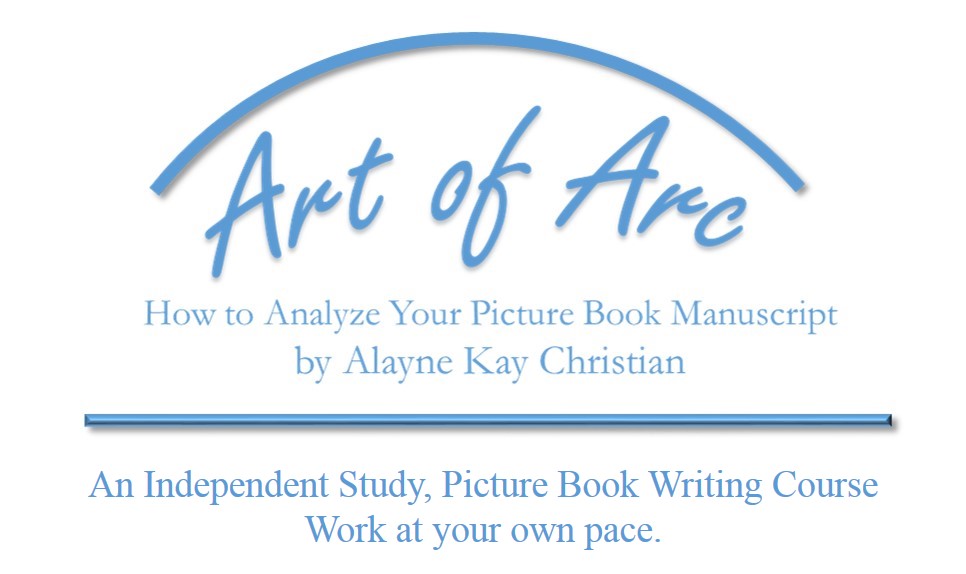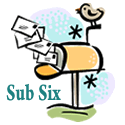
For our final “Wisdom” topic of the year, I asked the Kid-Lit Writing Wisdom team for their thoughts on writing effective and satisfying picture book endings. And with all the wisdom combined, we ended up with another great free course in picture book writing (although much of our wisdom can be applied to longer works). Our thoughts and tips on this topic will be presented in three parts, so keep an eye out for more. If you missed part one, click here. You can find a list of links to all of our 2021 Kid-Lit Writing Wisdom posts at the end of this post.
Today’s wisdom comes from Laura Gehl, Ellen Leventhal, Vivian Kirkfield, and Rob Sanders.

ENDING WITH A BONUS
by Laura Gehl
One of my favorite types of ending is when the main conflict is resolved before the final page, allowing the last spread or two to add a twist of humor or an extra layer to the story.
For example, in I Got a Chicken For My Birthday, by me and Sarah Horne, Ana is initially upset about getting a chicken as a gift from her grandmother, instead of the amusement park tickets that she had requested. This conflict is resolved when the chicken builds Ana a backyard amusement park and Ana realizes Abuela Lola knew exactly what she was doing. But the wonderful spread with Ana riding in eggshell-shaped roller coaster cars with Abuela Lola is not the end of the book! Afterward, Ana says, “Next year, I’m asking Abuela Lola for a trip to the moon!” and we see the chicken beginning to design a rocket ship.
In My Pillow Keeps Moving, by me and Christopher Weyant, a lonely man keeps accidentally purchasing a dog—first as a pillow, then as a footrest, and finally as a coat. The main conflict is resolved when the man decides to adopt the dog. But then the story continues with the dog winking at her feline friend, the man accidentally purchasing the cat as a hat, and all three becoming a happy family on the final page.
In Judge Juliette, by me and Mari Lobo, Judge Juliette has to rule on whether her family should get a dog (like her mom wants) or a cat (as her dad hopes). The main conflict is resolved when Juliette discovers she must recuse herself, since judges aren’t allowed to rule in cases involving family members. But the book ends on a funny twist when Juliette hands her courtroom and gavel over to a friend and takes on the role of lawyer instead. Juliette says she would like to make a case for getting a dog AND a cat…AND (on the final page!)…a boa constrictor.
These endings with a little extra twist are favorites for me as a reader (This Is Not My Hat by John Klassen is a great example) and as a writer. I love how this type of ending gives the reader the satisfaction of “Hooray, the conflict is resolved!” and then a bonus laugh, or an extra “Wow, I wasn’t expecting that!”
WHAT KIND OF ENDING WILL SET YOUR BOOK APART FROM THE REST?
by Ellen Leventhal
There are many different types of endings, all satisfying in their own way. I love endings with a twist, a surprise, a laugh, and even with an “aww.” Of course, your conclusion needs to stay in line with the rest of the book. You wouldn’t want a serious, quiet book to end with a big guffaw. A smile, yes, but probably not a huge laugh. Humorous books can definitely have an “aww” ending, but there needs to be a lead-up to it. It’s important to keep the character of your book throughout. When a funny book ends on an “aww” note, a fun thing to do is to have a humorous page turn that would tie it all together. It’s certainly not necessary, but it’s sometimes fun. I’m currently working on two humorous books that end with a sweet solution to the problem. However, the last page turns are both wordless spreads that tell the reader that something funny is about to happen.
I knew exactly what ending I wanted in A Flood of Kindness. It ends with an “aww” moment, but it wasn’t surprising. Readers could guess it may happen, but still, when it did, it was satisfying. (At least reviews say it is, and who am I to argue?) As an aside, illustrator Blythe Russo evoked such emotion that the reader roots for this main character from the minute they see her.
Lola Can’t Leap (by Noelle Shawa and me) has a surprise ending in the fact that the main character does NOT reach her goal, but she discovers something else. And then, Noelle made it even more surprising on the last page turn with her art.
I love circular stories where the end takes the reader back to the beginning of the story. There are so many wonderful circular stories. I recently re-read Maria Gianferrari and Bagram Ibatoulline’s Coyote Moon, which starts with Moonrise, takes us through the night, and ends with the coyote family waiting for the moon to wake them again.
Don’t Eat the Bluebonnets (written by Ellen Rothberg and me, illustrated by Joel Cook) is circular in the sense that when reading aloud, children cheer “Don’t eat the bluebonnets!” throughout the book. The last line invites them to echo it one last time.
Play around and see what will set YOUR book apart. And mostly, enjoy the process. Happy Writing!
ENDINGS THAT WRAP THINGS UP IN A NICE PACKAGE OF WORDS
by Vivian Kirkfield
Early on in my writing life, I attended a conference and heard Candace Fleming speak about picture book endings – and what she said made a huge impression on me. She told us that when a reader gets to the end of the book, they should be saying one of three things: HAHAHAHA, AHA! or AWWW.
Why, you ask? Because the emotional connection between the reader and the story is so very important. And, if the reader laughs at the end because the story was funny, or is surprised because there was a twist, or if the reader’s heart is touched, the author has succeeded.
For me, when I read the last lines of a story, I love to get a chill down my spine or a warm fuzzy feeling. For me, a ‘satisfying ending’ is an ending that tugs at my heart…it’s an ending that fulfills the promise of the opening lines of the story. Here are a couple of examples:
SWEET DREAMS, SARAH:
Opening Lines: Before the Civil War, Sarah obeyed her owner.
Hurry up!
Eyes down!
Don’t speak!
Slaves were property–like a cow, or plow, or the cotton that grew in the master’s fields.
Satisfying Ending: Sarah took a slow deep breath.
She slid out the papers.
She read out loud!
S.E. Goode
Cabinet Bed
No. 322,177. Patented July 14, 1885
Staring at her name in print, Sarah proudly traced each letter. Her idea, her invention, her name in history.
She had built more than a piece of furniture.
She had built a life far away from slavery, a life where her sweet dreams could come true.
MOON MAN: Robert Goddard and the Liquid Fuel-Propelled Rocket (One of the stories in FROM HERE TO THERE)
Opening Lines: Sometimes Robert Goddard’s curiosity was so intense, it made things explode.
Satisfying Ending: Robert Goddard ushered in the era of space flight with the world’s first liquid fuel-propelled rocket. Today’s space program is built on the discoveries he made, and for some of us, that trip to Mars young Robert dreamed about up in the cherry tree may one day become a reality.
ALL ABOARD: George Stephenson and the Steam Locomotive (One of the stories in FROM HERE TO THERE)
Opening Lines: Click! Clunk! Hiss!
Deep underground, in a maze of pitch-black tunnels, young George Stephenson hefted chunks of coal.
Satisfying Ending: The railway revolution had begun, and George Stephenson had led the charge, changing the landscape not only of England, but of the entire world.
One of the best ways to learn how to write satisfying endings is to read LOTS of them. Pick out your favorite picture books and use them as mentor texts. Examine the endings and observe how you feel when you read them. And then, go bravely into the morning or the night or whenever you do your best writing and play with those words until YOUR satisfying ending emerges!
MOVING FROM TROPES TO TREMENDOUS ENDINGS
by Rob Sanders
Sometimes to understand what something is, it’s helpful to know what it isn’t. Endings we grew up hearing or that were frequently used tropes, are a good place to look for what not to do.
That’s all folks. Bug’s Bunny may have been able to get away with his famous line to end Saturday morning cartoons, but as writers it’s not that easy. A story that just ends—without an ending—one that just stops without providing resolution or emotional climax, does not actually have an ending. Story doesn’t just end. It builds to and ending.
The End. As I always told student writers, “If you have to write THE END, then you haven’t written an ending.” The ending (even in nonfiction) is the conclusion of the plot. After the exposition, inciting incident, rising action, climax, and falling action, the ending brings the reader home and helps to create a feeling of completeness or wholeness for the piece.
They lived happily ever after. Oh, that the life really always ended with happily ever after. While most picture books do end happily or hopefully, the ending is really the place the author can create a variety of emotional impacts. In his pyramid plot structure, Freytag called this the denouement. Some define denouement as the emotional climax of the story. This emotional impact may affect the reader in a variety of ways. It may bring a smile, a tear, a cheer, a spine-tingling chill, an ah-h-h-h, and more.
And that’s the way it was. Walter Cronkite ended his CBS evening news broadcasts every night by saying, “And that’s the way it was.” Writers sometimes are tempted to conclude a story by recapping everything that has gone before. In this situation, the writer tries to ensure that the reader doesn’t miss out on anything important that’s come before. While the intention is good and while the approach might work on occasion, it also discredits readers and their ability to think, remember, and participate in the story.
The moral of the story. I grew up with books that made sure I understood the lesson or moral once I’d finished reading. Today, “The moral of the story,” should be saved for folktales. Yes, many current picture books do have a lesson or theme, but a skillfully written manuscript reveals that lesson or theme and a wise writer trusts the reader to make inferences to uncover the lesson or theme. (By the way, it’s ok if readers arrive different at different conclusions. It’s the magic of storytelling—each reader or listener can their own ideas about the story).
So, how do you end a picture book manuscript? Remember these tips:
- Don’t rely on tropes.
- Build to an ending.
- Make sure the ending completes the plot.
- Create an emotional impact.
- Trust your readers.
Allow readers to make their own inferences and to draw their own conclusions.
MORE WISDOM ON THE WAY!
Follow my blog or keep a close eye out because we have more “writing endings” wisdom coming from Dawn Prochovnic, Marcie Flinchum Atkins, Michelle Nott, and Pippa Chorley.
FOLLOWING ARE SOME LINKS TO OTHER KID-LIT WRITING WISDOM POSTS
KID-LIT WRITING WISDOM PRESENTS WRITING CAPTIVATING MIDDLES (Part 1 of 3)
KID-LIT WRITING WISDOM PRESENTS WRITING CAPTIVATING MIDDLES (Part 2 of 3)
KID-LIT WRITING WISDOM PRESENTS WRITING CAPTIVATING MIDDLES (Part 3 of 3)
HOW WRITE OUTSTANDING FIRST LINES AND BEGINNINGS (part1, part 2, part 3)
WHY KID-LIT WRITERS SHOULD READ MENTOR TEXTS AND HOW TO GET THE MOST OUT OF READING THEM PART ONE and PART TWO
THE MOST IMPORTANT LESSONS LEARNED IN MY PUBLICATION JOURNEY PART ONE and PART TWO
LONG AND WINDING ROAD: PUBLICATION DOESN’T (USUALLY) HAPPEN OVERNIGHT PART ONE, PART TWO, and PART THREE
INTRODUCING THE KID-LIT WRITING WISDOM TEAM
FOLLOWING ARE SOME LINKS TO OTHER KID-LIT WRITING WISDOM POSTS
KID-LIT WRITING WISDOM PRESENTS WRITING CAPTIVATING MIDDLES (Part 1 of 3)
KID-LIT WRITING WISDOM PRESENTS WRITING CAPTIVATING MIDDLES (Part 2 of 3)
KID-LIT WRITING WISDOM PRESENTS WRITING CAPTIVATING MIDDLES (Part 3 of 3)
HOW WRITE OUTSTANDING FIRST LINES AND BEGINNINGS (part1, part 2, part 3)
WHY KID-LIT WRITERS SHOULD READ MENTOR TEXTS AND HOW TO GET THE MOST OUT OF READING THEM PART ONE and PART TWO
THE MOST IMPORTANT LESSONS LEARNED IN MY PUBLICATION JOURNEY PART ONE and PART TWO
LONG AND WINDING ROAD: PUBLICATION DOESN’T (USUALLY) HAPPEN OVERNIGHT PART ONE, PART TWO, and PART THREE
INTRODUCING THE KID-LIT WRITING WISDOM TEAM
Read Full Post »
 So far, this year, I’ve been taking a break and being kind to myself. Meanwhile, the Kid-Lit Writing Wisdom team members have been doing their own thing. I believe that in the future I will be offering periodic guest posts from wise authors and/or illustrators, so keep an eye out. Before I move on to talking about picture book structures, I want to mention that my book BUTTERFLY KISSES FOR GRANDMA AND GRANDPA is featured in the summer reading section of the recent County Line Magazine. There are a couple cool things about this nice surprise. First, they put me in the great company of two other Texas authors Rosie Pova and Jen Betton. Rosie’s book SUNDAY RAIN (illustrated by Amariah Rauscher) is featured and author/illustrator Jen Betton’s cute book HEDGEHOG NEEDS A HUG is featured. The other thing that surprised me about BUTTERFLY KISSES FOR GRANDMA AND GRANDPA is that out of all my books, they picked the one that has been around the longest. What I love about this is the fact that my first picture book has had such a long life. I believe it may be the top seller of all my books, even after all these years.
So far, this year, I’ve been taking a break and being kind to myself. Meanwhile, the Kid-Lit Writing Wisdom team members have been doing their own thing. I believe that in the future I will be offering periodic guest posts from wise authors and/or illustrators, so keep an eye out. Before I move on to talking about picture book structures, I want to mention that my book BUTTERFLY KISSES FOR GRANDMA AND GRANDPA is featured in the summer reading section of the recent County Line Magazine. There are a couple cool things about this nice surprise. First, they put me in the great company of two other Texas authors Rosie Pova and Jen Betton. Rosie’s book SUNDAY RAIN (illustrated by Amariah Rauscher) is featured and author/illustrator Jen Betton’s cute book HEDGEHOG NEEDS A HUG is featured. The other thing that surprised me about BUTTERFLY KISSES FOR GRANDMA AND GRANDPA is that out of all my books, they picked the one that has been around the longest. What I love about this is the fact that my first picture book has had such a long life. I believe it may be the top seller of all my books, even after all these years.







 Beth Anderson, a former English as a Second Language teacher, has always marveled at the power of books. With linguistics and reading degrees, a fascination with language, and a penchant for untold tales, she strives for accidental learning in the midst of a great story. Beth lives in Loveland, Colorado where she laughs, ponders, and questions; and hopes to inspire kids to do the same. She’s the award-winning author of
Beth Anderson, a former English as a Second Language teacher, has always marveled at the power of books. With linguistics and reading degrees, a fascination with language, and a penchant for untold tales, she strives for accidental learning in the midst of a great story. Beth lives in Loveland, Colorado where she laughs, ponders, and questions; and hopes to inspire kids to do the same. She’s the award-winning author of 


























